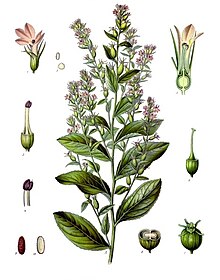Lobelia inflata, also known as Indian tobacco or puke weed, is a species of Lobelia native to eastern North America, from southeastern Canada (Nova Scotia to southeast Ontario) south through the eastern United States to Alabama and west to Kansas.[3]
| Indian tobacco | |
|---|---|

| |
| Lobelia inflata[1] | |
| Scientific classification | |
| Kingdom: | Plantae |
| Clade: | Tracheophytes |
| Clade: | Angiosperms |
| Clade: | Eudicots |
| Clade: | Asterids |
| Order: | Asterales |
| Family: | Campanulaceae |
| Genus: | Lobelia |
| Species: | L. inflata
|
| Binomial name | |
| Lobelia inflata | |
Description
editLobelia inflata is an annual or biennial herbaceous plant growing to 15–100 cm (5.9–39.4 in) tall, with stems covered in tiny hairs. Its leaves are usually about 8 cm (3.1 in) long, and are ovate and toothed. They are alternately arranged. It has violet colored flowers that are tinted yellow on the inside, and usually appear in mid-summer and continue to bloom into fall.[4] The seedcases are small, brown, dehiscent, and papery.[5]
Propagation
editPropagation is usually accomplished by cuttings or seed. Seeds are sown in containers in mid spring or mid fall. The seeds take about 2 weeks to germinate.
Traditional uses and adverse effects
editLobelia inflata has a long use as a medicinal plant as an entheogenic, emetic, and skin or respiratory aid.[6][7] Native Americans used it for respiratory and muscle disorders, as a purgative, and as a ceremonial medicine.[6][7] The leaves were chewed and smoked.[8] The plant was used as a traditional medicinal plant by the Cherokee, Iroquois, Penobscot, and other indigenous peoples.[7] The foliage was burned by the Cherokee as a natural insecticide, to smoke out gnats.[7]
Although it may be used medicinally,[9] consuming lobelia causes adverse effects, which may include sweating, nausea, vomiting, diarrhea, tremors, rapid heartbeat, mental confusion, convulsions, hypothermia, coma, or possibly death.[6][10] The root is toxic and can be fatal if eaten.[6][8]
Chemical constituents
editLobelia inflata contains multiple alkaloid compounds, including lobeline, norlobelanine, lobelanidine, and radicamine, among other compounds, such as flavonoids, terpenes, alkynes, and coumarins.[6][11][12] Lobeline concentration is highest in the seeds.[6]
References
edit- ^ Franz Eugen Köhler, 1897, Köhler's Medizinal-Pflanzen
- ^ NatureServe (30 June 2023). "Lobelia inflata". NatureServe Network Biodiversity Location Data accessed through NatureServe Explorer. Arlington, Virginia: NatureServe. Retrieved 23 July 2023.
- ^ "Lobelia inflata". Germplasm Resources Information Network. Agricultural Research Service, United States Department of Agriculture. Retrieved 2009-04-09.
- ^ Caldecott, T. Western Materia Medica: Lobelia inflata (pdf file)[permanent dead link]
- ^ "Some Call Them Weeds". 2016-01-02.
- ^ a b c d e f "Lobelia". Drugs.com. 21 April 2021. Retrieved 20 January 2021.
- ^ a b c d University of Michigan at Dearborn: Native American Ethnobotany of Lobelia inflata
- ^ a b Niering, William A.; Olmstead, Nancy C. (1985) [1979]. The Audubon Society Field Guide to North American Wildflowers, Eastern Region. Knopf. p. 441. ISBN 0-394-50432-1.
- ^ "Lobelia". EBSCO Complementary and Alternative Medicine (CAM) Review Board. January 2006. Retrieved 2007-09-12.
- ^ "Lobelia". University of Maryland Medical Center. Archived from the original on 2017-06-29.
It may cause serious side effects, such as profuse sweating, nausea, vomiting, diarrhea, tremors, rapid heartbeat, mental confusion, convulsions and hypothermia.
- ^ Kursinszki, László; Szőke, Éva (2015). "HPLC-ESI-MS/MS of brain neurotransmitter modulator lobeline and related piperidine alkaloids in Lobelia inflataL". Journal of Mass Spectrometry. 50 (5): 727–33. Bibcode:2015JMSp...50..727K. doi:10.1002/jms.3581. PMID 26259655.
- ^ "Taxon: Lobelia inflata L." National Plant Germplasm System.
